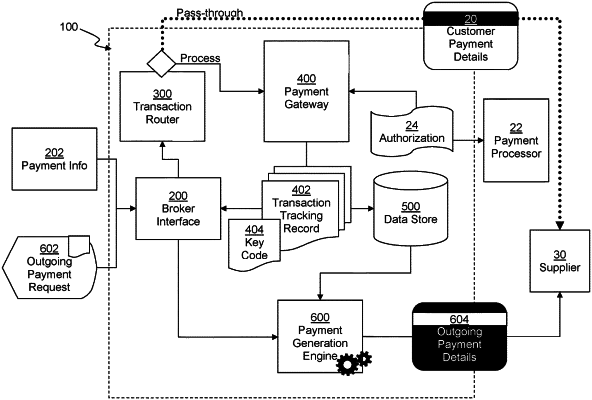| CPC G06Q 20/027 (2013.01) [G06Q 20/227 (2013.01); G06Q 20/3829 (2013.01); G06Q 20/4016 (2013.01); G06Q 20/405 (2013.01); G06Q 30/0226 (2013.01)] | 19 Claims |

|
1. A system for providing on-demand outgoing payment details, the system comprising:
a memory storing computer-readable instructions that when executed by a processor cause the processor to implement:
a network-connected interface to receive customer payment details, associated with a first payment type, for payment of an incoming amount, wherein the incoming amount includes a combination amount of one or more purchase types;
a data store configured to store:
a plurality of transaction tracking records, each transaction tracking record comprising a unique key code and an allocatable amount; and
a plurality of payment type profiles, each payment type profile associating a payment type with one or more payment attributes;
a payment gateway, communicably coupled to a payment processor and configured to:
request authorization data for payment of the incoming amount from the payment processor,
store a transaction tracking record in the data store upon receipt of the authorization data, the allocatable amount of the transaction tracking record being initialized to a value less than or equal to the incoming amount, and the unique key code being initialized to a cryptographic hash value calculated based on the authorization data and a current date and time;
an outgoing payment generator configured to:
receive at least one outgoing payment request, associated with the one or more purchase types, comprising an offered key code and an outgoing amount;
for each outgoing payment request having an offered key code matching a unique key code of an existing transaction tracking record in the data store, generate outgoing payment details, associated with at least a second payment type, wherein the second payment type is associated with one of a second brand, organization, or group alternative to the first payment type for purchase of an outgoing first purchase type and a third payment type, wherein the third payment type is associated with one of a third brand, organization, or group alternative to the first and second payment types for outgoing purchase of a second purchase type; and
reduce the allocatable amount of the existing transaction tracking record by the outgoing amount if the outgoing amount is less than or equal to the allocatable amount, wherein the at least second and third payment types, selected between multiple payment types, is selected by a filter defined by a plurality of transaction preferences comprising one or more optimization goals associated with the one of the brands, organizations, or groups in compliance with the filter, wherein the filter selection maintains an outgoing percentage or currency amount distributed between the multiple payment types within a predetermined period of time, and wherein the filter selection dynamically updates expected fees based on historic fees to predict likely fee amounts for each payment type.
|